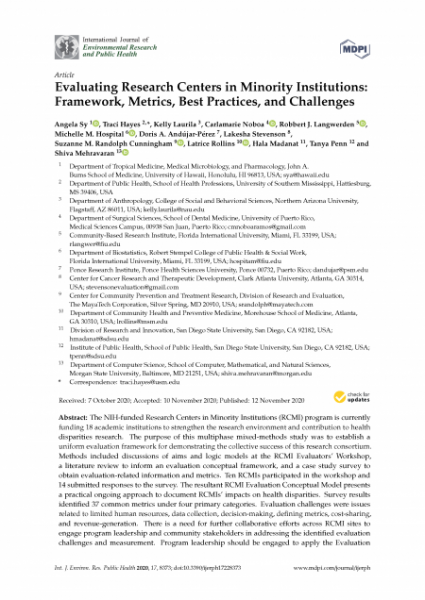Publications
Implementation of a brief motivational intervention for alcohol and other drug using Latinx college students
Implementation of a brief motivational intervention for alcohol and other drug using Latinx college students.
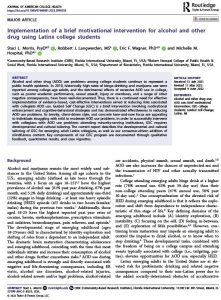 Abstract: Alcohol and other drug (AOD) use problems among college students continue to represent a public health epidemic. In 2019, historically high rates of binge-drinking and marijuana use were reported among college-age adults, and the detrimental effects of excessive AOD use in college, such as poorer academic performance, sexual assault, injury or overdoses, and a range of other negative consequences, have been well-documented. Thus, there is a continued need for effective implementation of evidence-based, cost-effective interventions aimed at reducing risks associated with collegiate AOD use. Guided Self Change (GSC) is a brief intervention involving motivational enhancement and cognitive-behavioral strategies and has demonstrated effectiveness in reducing AOD use problems. Its brevity, client-driven style, and concrete here-and-now focus are appealing to individuals struggling with mild to moderate AOD use problems. In order to successfully intervene with collegians with AOD use problems attending minority-serving institutions, GSC requires developmental and cultural tailoring. The current report describes the developmental and cultural tailoring of GSC for emerging adult Latinx collegians, as well as our consumer-driven addition of mindfulness content. Key components of our GSC program are documented through qualitative
Abstract: Alcohol and other drug (AOD) use problems among college students continue to represent a public health epidemic. In 2019, historically high rates of binge-drinking and marijuana use were reported among college-age adults, and the detrimental effects of excessive AOD use in college, such as poorer academic performance, sexual assault, injury or overdoses, and a range of other negative consequences, have been well-documented. Thus, there is a continued need for effective implementation of evidence-based, cost-effective interventions aimed at reducing risks associated with collegiate AOD use. Guided Self Change (GSC) is a brief intervention involving motivational enhancement and cognitive-behavioral strategies and has demonstrated effectiveness in reducing AOD use problems. Its brevity, client-driven style, and concrete here-and-now focus are appealing to individuals struggling with mild to moderate AOD use problems. In order to successfully intervene with collegians with AOD use problems attending minority-serving institutions, GSC requires developmental and cultural tailoring. The current report describes the developmental and cultural tailoring of GSC for emerging adult Latinx collegians, as well as our consumer-driven addition of mindfulness content. Key components of our GSC program are documented through qualitative
feedback, quantitative results, and case vignettes.
Morris, S. L., Langwerden, R. J., Wagner, E. F., & Hospital, M. M. (2022). Implementation of a brief motivational intervention for alcohol and other drug using Latinx college students. Journal of American College Health, 1-11. https://doi.org/10.1080/07448481.2022.2090258.
A Latent Profile Analysis of COVID-19 Trusted Sources of Information among Racial and Ethnic Minorities in South Florida
Latent Profile Analysis of COVID-19 Trusted Sources of Information among Racial and Ethnic Minorities in South Florida.
 Abstract: By the spring of 2021, most of the adult U.S. population became eligible to receive a COVID-19 vaccine. Yet, by the summer of 2021, the vaccination rate stagnated. Given the immense impact COVID-19 has had on society and individuals, and the surge of new variant strains of the virus, it remains urgent to better understand barriers to vaccination, including the impact of variations in trusted sources of COVID-19 information. The goal of the present study was to conduct a cross-sectional, community-engaged, and person-centered study of trusted sources of COVID-19 information using latent profile analysis (LPA). The aims were to (1) identify the number and nature of profiles of trusted sources of COVID-19 information, and (2) determine whether the trust profiles were predictive of COVID-19 vaccination attitudes and various demographic categories. Participants included mostly racial and ethnic minority individuals (82.4%) recruited by various community-based agencies in South Florida. The LPA evidenced an optimal 3-class solution characterized by low (n= 80)-, medium (n= 147)-, and high (n= 52)-trust profiles, with high trust statistically significantly predictive of vaccination willingness. The profiles identified could be important targets for public health dissemination efforts to reduce vaccine hesitancy and increase COVID-19 vaccination uptake. The general level of trust in COVID-19 information sources was found to be an important factor in predicting COVID-19 vaccination willingness
Abstract: By the spring of 2021, most of the adult U.S. population became eligible to receive a COVID-19 vaccine. Yet, by the summer of 2021, the vaccination rate stagnated. Given the immense impact COVID-19 has had on society and individuals, and the surge of new variant strains of the virus, it remains urgent to better understand barriers to vaccination, including the impact of variations in trusted sources of COVID-19 information. The goal of the present study was to conduct a cross-sectional, community-engaged, and person-centered study of trusted sources of COVID-19 information using latent profile analysis (LPA). The aims were to (1) identify the number and nature of profiles of trusted sources of COVID-19 information, and (2) determine whether the trust profiles were predictive of COVID-19 vaccination attitudes and various demographic categories. Participants included mostly racial and ethnic minority individuals (82.4%) recruited by various community-based agencies in South Florida. The LPA evidenced an optimal 3-class solution characterized by low (n= 80)-, medium (n= 147)-, and high (n= 52)-trust profiles, with high trust statistically significantly predictive of vaccination willingness. The profiles identified could be important targets for public health dissemination efforts to reduce vaccine hesitancy and increase COVID-19 vaccination uptake. The general level of trust in COVID-19 information sources was found to be an important factor in predicting COVID-19 vaccination willingness
Langwerden, R. J., Wagner, E. F., Hospital, M. M., Morris, S. L., Cueto, V., Carrasquillo, O., … & Campa, A. L. (2022). A Latent Profile Analysis of COVID-19 Trusted Sources of Information among Racial and Ethnic Minorities in South Florida. Vaccines, 10(4), 545. https://doi.org/10.3390/vaccines10040545.
Virtual Town Halls Addressing Vaccine Hesitancy Among Racial/Ethnic Minorities: Preliminary Findings
Virtual Town Halls Addressing Vaccine Hesitancy Among Racial/Ethnic Minorities: Preliminary Findings.
 Abstract: Background: The coronavirus disease 2019 (COVID-19) pandemic remains a public health priority, and vaccination is important for ending the pandemic. Racial and ethnic minorities are disproportionally affected by COVID-19 yet report high levels of vaccination hesitancy. Objective: We conducted virtual town halls to address vaccine hesitancy among racial and ethnic minorities in South Florida. Methods: Our approach used social influence and persuasion models. In a formative phase, we gathered meeting preferences from our communities and developed and tested our approach. In an implementation phase, we conducted 6 virtual town halls in partnership with 6 different minority-focused community-based organizations. Results: The town halls reached 379 participants (mean age 36.6 years; 63.9% female, 33.5% male, 0.3% nonbinary; 55.7% racial or ethnic minority). Of these 379 participants, 69 completed both polls who were unvaccinated at the time. Among these nonvaccinated participants, at the prepoll, 58% reported a high likelihood of seeking vaccination, rising to 72.5% at the exit poll, which was a statistically significant change. Unvaccinated non-hesitant and hesitant groups were compared on trusted information sources and reasons and barriers for vaccination. Nonhesitant participants reported greater trust in the COVID-19 Task Force (97.2% vs. 82.3%) as a source of vaccine information than did hesitant participants. Nonhesitant participants were statistically significant more likely to endorse community safety (74.4% vs. 27.8%), personal safety (87.2% vs. 38.9%), and wanting to return to a normal life (71.8% vs. 33.3%) as reasons for vaccination than were hesitant participants. Hesitant participants were statistically significant more likely to endorse concerns about vaccine safety (61.1% vs. 17.9%) as barrier to vaccination than were nonhesitant participants. Qualitative data revealed high consumer satisfaction with the town halls. Conclusion: This study supports the feasibility, acceptability, and potential impact of virtual town halls for addressing vaccine hesitancy among racial or ethnic minorities; however, our approach was resource intensive, required an extensive community-university collaborative infrastructure, and yielded a small effect.
Abstract: Background: The coronavirus disease 2019 (COVID-19) pandemic remains a public health priority, and vaccination is important for ending the pandemic. Racial and ethnic minorities are disproportionally affected by COVID-19 yet report high levels of vaccination hesitancy. Objective: We conducted virtual town halls to address vaccine hesitancy among racial and ethnic minorities in South Florida. Methods: Our approach used social influence and persuasion models. In a formative phase, we gathered meeting preferences from our communities and developed and tested our approach. In an implementation phase, we conducted 6 virtual town halls in partnership with 6 different minority-focused community-based organizations. Results: The town halls reached 379 participants (mean age 36.6 years; 63.9% female, 33.5% male, 0.3% nonbinary; 55.7% racial or ethnic minority). Of these 379 participants, 69 completed both polls who were unvaccinated at the time. Among these nonvaccinated participants, at the prepoll, 58% reported a high likelihood of seeking vaccination, rising to 72.5% at the exit poll, which was a statistically significant change. Unvaccinated non-hesitant and hesitant groups were compared on trusted information sources and reasons and barriers for vaccination. Nonhesitant participants reported greater trust in the COVID-19 Task Force (97.2% vs. 82.3%) as a source of vaccine information than did hesitant participants. Nonhesitant participants were statistically significant more likely to endorse community safety (74.4% vs. 27.8%), personal safety (87.2% vs. 38.9%), and wanting to return to a normal life (71.8% vs. 33.3%) as reasons for vaccination than were hesitant participants. Hesitant participants were statistically significant more likely to endorse concerns about vaccine safety (61.1% vs. 17.9%) as barrier to vaccination than were nonhesitant participants. Qualitative data revealed high consumer satisfaction with the town halls. Conclusion: This study supports the feasibility, acceptability, and potential impact of virtual town halls for addressing vaccine hesitancy among racial or ethnic minorities; however, our approach was resource intensive, required an extensive community-university collaborative infrastructure, and yielded a small effect.
Wagner, E. F., Langwerden, R. J., Morris, S. L., Ward, M. K., Trepka, M. J., Campa, A. L., … & Hospital, M. M. (2021). Virtual Town Halls Addressing Vaccine Hesitancy Among Racial/Ethnic Minorities: Preliminary Findings. Journal of the American Pharmacists Association, 62(2022), 317-325. https://doi.org/10.1016/j.japh.2021.11.005
Feasibility, acceptability and preliminary impact of mindfulness-based yoga among Hispanic/Latinx adolescents
Feasibility, acceptability and preliminary impact of mindfulness-based yoga among Hispanic/Latinx adolescents
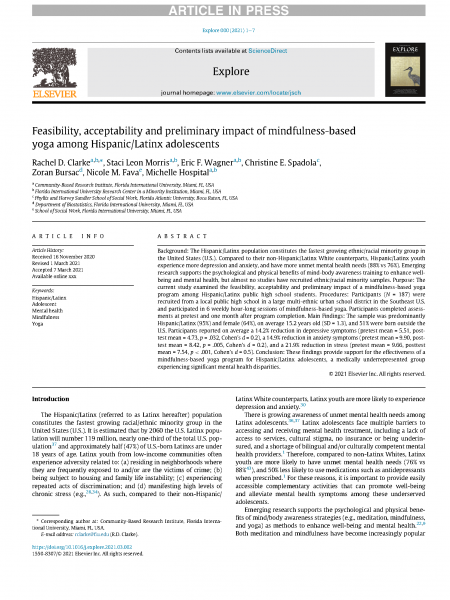 Background: The Hispanic/Latinx population constitutes the fastest growing ethnic/racial minority group in the United States (U.S.). Compared to their non-Hispanic/Latinx White counterparts, Hispanic/Latinx youth experience more depression and anxiety, and have more unmet mental health needs (88% vs 76%). Emerging research supports the psychological and physical benefits of mind-body awareness training to enhance well-being and mental health, but almost no studies have recruited ethnic/racial minority samples. Purpose: The current study examined the feasibility, acceptability and preliminary impact of a mindfulness-based yoga program among Hispanic/Latinx public high school students. Procedures: Participants (N = 187) were recruited from a local public high school in a large multi-ethnic urban school district in the Southeast U.S. and participated in 6 weekly hour-long sessions of mindfulness-based yoga. Participants completed assessments at pretest and one month after program completion. Main Findings: The sample was predominantly Hispanic/Latinx (95%) and female (64%), on average 15.2 years old (SD = 1.3), and 51% were born outside the U.S. Participants reported on average a 14.2% reduction in depressive symptoms (pretest mean = 5.51, posttest mean = 4.73, p = .032, Cohen’s d = 0.2), a 14.9% reduction in anxiety symptoms (pretest mean = 9.90, posttest mean = 8.42, p = .005, Cohen’s d = 0.2), and a 21.9% reduction in stress (pretest mean = 9.66, posttest mean = 7.54, p < .001, Cohen’s d = 0.5). Conclusion: These findings provide support for the effectiveness of a mindfulness-based yoga program for Hispanic/Latinx adolescents, a medically underrepresented group experiencing significant mental health disparities.
Background: The Hispanic/Latinx population constitutes the fastest growing ethnic/racial minority group in the United States (U.S.). Compared to their non-Hispanic/Latinx White counterparts, Hispanic/Latinx youth experience more depression and anxiety, and have more unmet mental health needs (88% vs 76%). Emerging research supports the psychological and physical benefits of mind-body awareness training to enhance well-being and mental health, but almost no studies have recruited ethnic/racial minority samples. Purpose: The current study examined the feasibility, acceptability and preliminary impact of a mindfulness-based yoga program among Hispanic/Latinx public high school students. Procedures: Participants (N = 187) were recruited from a local public high school in a large multi-ethnic urban school district in the Southeast U.S. and participated in 6 weekly hour-long sessions of mindfulness-based yoga. Participants completed assessments at pretest and one month after program completion. Main Findings: The sample was predominantly Hispanic/Latinx (95%) and female (64%), on average 15.2 years old (SD = 1.3), and 51% were born outside the U.S. Participants reported on average a 14.2% reduction in depressive symptoms (pretest mean = 5.51, posttest mean = 4.73, p = .032, Cohen’s d = 0.2), a 14.9% reduction in anxiety symptoms (pretest mean = 9.90, posttest mean = 8.42, p = .005, Cohen’s d = 0.2), and a 21.9% reduction in stress (pretest mean = 9.66, posttest mean = 7.54, p < .001, Cohen’s d = 0.5). Conclusion: These findings provide support for the effectiveness of a mindfulness-based yoga program for Hispanic/Latinx adolescents, a medically underrepresented group experiencing significant mental health disparities.
Clarke, R. D., Morris, S. L., Wagner, E. F., Spadola, C. E., Bursac, Z., Fava, N. M., & Hospital, M. M. (2021). Feasibility, acceptability and preliminary impact of mindfulness-based yoga among Hispanic/Latinx adolescents. EXPLORE. doi:10.1016/j.explore.2021.03.002
Multidimensional conceptualization of identity and psychopathology: Assessing mental health disparities from an intersectional and dimensional framework
Multidimensional conceptualization of identity and psychopathology: Assessing mental health disparities from an intersectional and dimensional framework
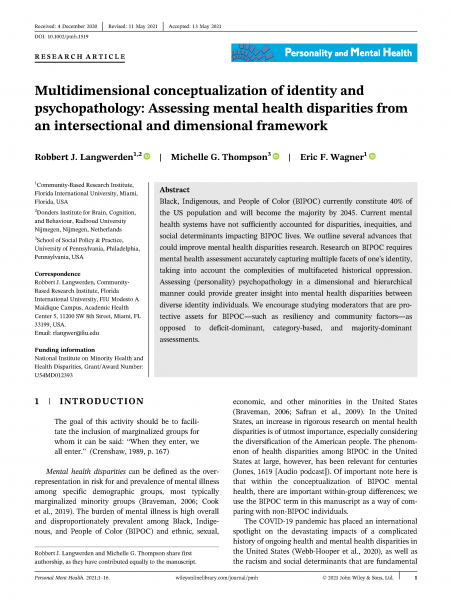 Abstract: Black, Indigenous, and People of Color (BIPOC) currently constitute 40% of the US population and will become the majority by 2045. Current mental health systems have not sufficiently accounted for disparities, inequities, and social determinants impacting BIPOC lives. We outline several advances that could improve mental health disparities research. Research on BIPOC requires mental health assessment accurately capturing multiple facets of one’s identity, taking into account the complexities of multifaceted historical oppression. Assessing (personality) psychopathology in a dimensional and hierarchical manner could provide greater insight into mental health disparities between diverse identity individuals. We encourage studying moderators that are protective assets for BIPOC—such as resiliency and community factors—as opposed to deficit-dominant, category-based, and majority-dominant assessments.
Abstract: Black, Indigenous, and People of Color (BIPOC) currently constitute 40% of the US population and will become the majority by 2045. Current mental health systems have not sufficiently accounted for disparities, inequities, and social determinants impacting BIPOC lives. We outline several advances that could improve mental health disparities research. Research on BIPOC requires mental health assessment accurately capturing multiple facets of one’s identity, taking into account the complexities of multifaceted historical oppression. Assessing (personality) psychopathology in a dimensional and hierarchical manner could provide greater insight into mental health disparities between diverse identity individuals. We encourage studying moderators that are protective assets for BIPOC—such as resiliency and community factors—as opposed to deficit-dominant, category-based, and majority-dominant assessments.
Langwerden, R. J.*, Thompson, M. G.*, & Wagner, E. F. (2021). Multidimensional conceptualization of identity and psychopathology: Assessing mental health disparities from an intersectional and dimensional framework. Personality and Mental Health, 15(4), 293-308. https://doi.org/10.1002/pmh.1519. *shared first authorship.
A review investigating the relationship between cannabis use and adolescent cognitive functioning
A review investigating the relationship between cannabis use and adolescent cognitive functioning
 Given varying state-level laws regarding cannabis use, the objective of the review was to summarize contemporary literature on the relationship between adolescent cognitive function and academic performance with cannabis use. Frequency and quantity of cannabis use were associated with decreased functional connectivity of the brain. Earlier age at cannabis initiation and more frequent use was associated with poorer executive control and academic performance. Social determinants such as minimal parental monitoring, peer use and low social cohesion were associated with more frequent adolescent use. Race/ethnicity and residence were other factors influencing cannabis use. To prevent cannabis use disorders among adolescents, interventions should aim to prevent early initiation that can lead to chronic use in youth who may be more at risk.
Given varying state-level laws regarding cannabis use, the objective of the review was to summarize contemporary literature on the relationship between adolescent cognitive function and academic performance with cannabis use. Frequency and quantity of cannabis use were associated with decreased functional connectivity of the brain. Earlier age at cannabis initiation and more frequent use was associated with poorer executive control and academic performance. Social determinants such as minimal parental monitoring, peer use and low social cohesion were associated with more frequent adolescent use. Race/ethnicity and residence were other factors influencing cannabis use. To prevent cannabis use disorders among adolescents, interventions should aim to prevent early initiation that can lead to chronic use in youth who may be more at risk.
Cyrus, E., Coudray, M. S., Kiplagat, S., Mariano, Y., Noel, I., Galea, J. T., … & Wagner, E. (2021). A review investigating the relationship between cannabis use and adolescent cognitive functioning. Current Opinion in Psychology, 38(38-48). doi: 10.1016/j.copsyc.2020.07.006.
46213 Florida Community-Engaged Research Alliance against COVID-19 in disproportionately affected Communities (FL-CEAL): Addressing education, awareness, access, and inclusion of underserved communities in COVID-19 research
Sacred Connections: A university-tribal clinical research partnership for school-based screening and brief intervention for substance use problems among Native American youth
SACRED Connections: A university-tribal clinical research partnership for school-based screening and brief intervention for substance use problems among Native American youth
 Abstract: Native American (NA) youth report higher rates of alcohol, marijuana, and drug use than U.S. adolescents from any other racial/ethnic group. Addressing this health disparity is a significant research priority across public health, minority health, and dissemination and implementation (D&I) sciences, underscoring the need for empirically-based interventions tailored for NA youth. Effective D&I with NA youth incorporates NA cultural values and involves tribal elders and stakeholders. SACRED Connections (NIDA R01DA02977) was a university-tribal research partnership that utilized a culturally derived Native-Reliance theoretical framework and a community-based participatory research (CBPR) approach. A significant objective of this randomized controlled trial was to close D&I gaps utilizing the RE-AIM Model and National Culturally and Linguistically Appropriate Services (CLAS) in Health and Health Care Standards (HHS, 2019). Findings of this 5-year RCT revealed a statistically significant protective relationship between Native Reliance and baseline lifetime and past month alcohol and marijuana use; additionally, the likelihood of reporting marijuana use at 3 months post-intervention was significantly lower among the active condition than among the control condition. Implementation of a developmentally and NA culturally tailored brief protocol revealed: partnering with Native Americans and utilizing CBPR facilitated engagement with this hard-to-reach, underserved community; age and culture are associated with substance use severity among NA teens; a culturally adapted Motivational Interviewing (MI) brief intervention may be effective in reducing marijuana use among NA youth; the Native Reliance theory proved useful as a framework for working with this population; and RE-AIM proved helpful in conceptualizing health equity promoting D&I.
Abstract: Native American (NA) youth report higher rates of alcohol, marijuana, and drug use than U.S. adolescents from any other racial/ethnic group. Addressing this health disparity is a significant research priority across public health, minority health, and dissemination and implementation (D&I) sciences, underscoring the need for empirically-based interventions tailored for NA youth. Effective D&I with NA youth incorporates NA cultural values and involves tribal elders and stakeholders. SACRED Connections (NIDA R01DA02977) was a university-tribal research partnership that utilized a culturally derived Native-Reliance theoretical framework and a community-based participatory research (CBPR) approach. A significant objective of this randomized controlled trial was to close D&I gaps utilizing the RE-AIM Model and National Culturally and Linguistically Appropriate Services (CLAS) in Health and Health Care Standards (HHS, 2019). Findings of this 5-year RCT revealed a statistically significant protective relationship between Native Reliance and baseline lifetime and past month alcohol and marijuana use; additionally, the likelihood of reporting marijuana use at 3 months post-intervention was significantly lower among the active condition than among the control condition. Implementation of a developmentally and NA culturally tailored brief protocol revealed: partnering with Native Americans and utilizing CBPR facilitated engagement with this hard-to-reach, underserved community; age and culture are associated with substance use severity among NA teens; a culturally adapted Motivational Interviewing (MI) brief intervention may be effective in reducing marijuana use among NA youth; the Native Reliance theory proved useful as a framework for working with this population; and RE-AIM proved helpful in conceptualizing health equity promoting D&I.
Morris, S.L., Hospital, M.M., Wagner, E.F., Lowe, J., Thompson, M.G., Clarke, R., Riggs, C. (2021). Sacred Connections: A university-tribal clinical research partnership for school-based screening and brief intervention for substance use problems among Native American youth. Journal of Ehnic & Cultural Diversity in Social Work, 30(1):149-162. doi: 10.1080/15313204.2020.1770654
Recovery in Special Emphasis Populations
Recovery in special emphasis populations
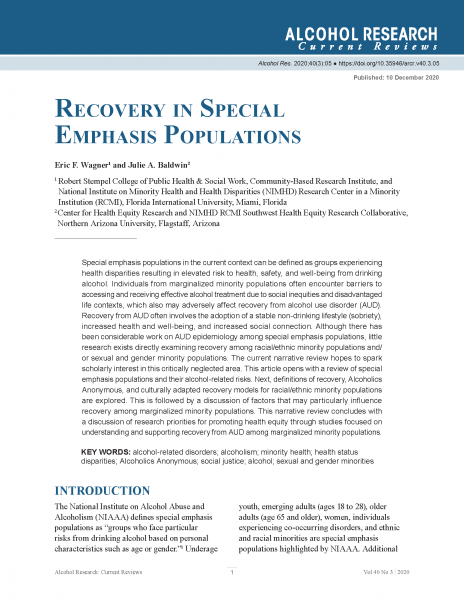 Special emphasis populations in the current context can be defined as groups experiencing health disparities resulting in elevated risk to health, safety, and well-being from drinking alcohol. Individuals from marginalized minority populations often encounter barriers to accessing and receiving effective alcohol treatment due to social inequities and disadvantaged life contexts, which also may adversely affect recovery from alcohol use disorder (AUD). Recovery from AUD often involves the adoption of a stable non-drinking lifestyle (sobriety), increased health and well-being, and increased social connection. Although there has been considerable work on AUD epidemiology among special emphasis populations, little research exists directly examining recovery among racial/ethnic minority populations and/or sexual and gender minority populations. The current narrative review hopes to spark scholarly interest in this critically neglected area. This article opens with a review of special emphasis populations and their alcohol-related risks. Next, definitions of recovery, Alcoholics Anonymous, and culturally adapted recovery models for racial/ethnic minority populations are explored. This is followed by a discussion of factors that may particularly influence recovery among marginalized minority populations. This narrative review concludes with a discussion of research priorities for promoting health equity through studies focused on understanding and supporting recovery from AUD among marginalized minority populations.
Special emphasis populations in the current context can be defined as groups experiencing health disparities resulting in elevated risk to health, safety, and well-being from drinking alcohol. Individuals from marginalized minority populations often encounter barriers to accessing and receiving effective alcohol treatment due to social inequities and disadvantaged life contexts, which also may adversely affect recovery from alcohol use disorder (AUD). Recovery from AUD often involves the adoption of a stable non-drinking lifestyle (sobriety), increased health and well-being, and increased social connection. Although there has been considerable work on AUD epidemiology among special emphasis populations, little research exists directly examining recovery among racial/ethnic minority populations and/or sexual and gender minority populations. The current narrative review hopes to spark scholarly interest in this critically neglected area. This article opens with a review of special emphasis populations and their alcohol-related risks. Next, definitions of recovery, Alcoholics Anonymous, and culturally adapted recovery models for racial/ethnic minority populations are explored. This is followed by a discussion of factors that may particularly influence recovery among marginalized minority populations. This narrative review concludes with a discussion of research priorities for promoting health equity through studies focused on understanding and supporting recovery from AUD among marginalized minority populations.
Wagner, E. F., & Baldwin, J. A. (2020). Recovery in Special Emphasis Populations. Alcohol Research: Current Reviews, 40(3). doi:10.35946/arcr.v40.3.05
Evaluating Research Centers in Minority Institutions: Framework, Metrics, Best Practices, and Challenges
Evaluating Research Centers in Minority Institutions: Framework, metrics, best practices, and challenges
Abstract: The NIH-funded Research Centers in Minority Institutions (RCMI) program is currently funding 18 academic institutions to strengthen the research environment and contribution to health disparities research. The purpose of this multiphase mixed-methods study was to establish a uniform evaluation framework for demonstrating the collective success of this research consortium. Methods included discussions of aims and logic models at the RCMI Evaluators’ Workshop, a literature review to inform an evaluation conceptual framework, and a case study survey to obtain evaluation-related information and metrics. Ten RCMIs participated in the workshop and 14 submitted responses to the survey. The resultant RCMI Evaluation Conceptual Model presents a practical ongoing approach to document RCMIs’ impacts on health disparities. Survey results identified 37 common metrics under four primary categories. Evaluation challenges were issues related to limited human resources, data collection, decision-making, defining metrics, cost-sharing, and revenue-generation. There is a need for further collaborative efforts across RCMI sites to engage program leadership and community stakeholders in addressing the identified evaluation challenges and measurement. Program leadership should be engaged to apply the Evaluation.
Sy, A., Hayes, T., Laurila, K., Noboa, C., Langwerden, R. J., Andújar-Pérez, D. A., … & Penn, T. (2020). Evaluating Research Centers in Minority Institutions: Framework, Metrics, Best Practices, and Challenges. International Journal of Environmental Research and Public Health, 17(22), 8373. doi: 10.3390/ijerph17228373

